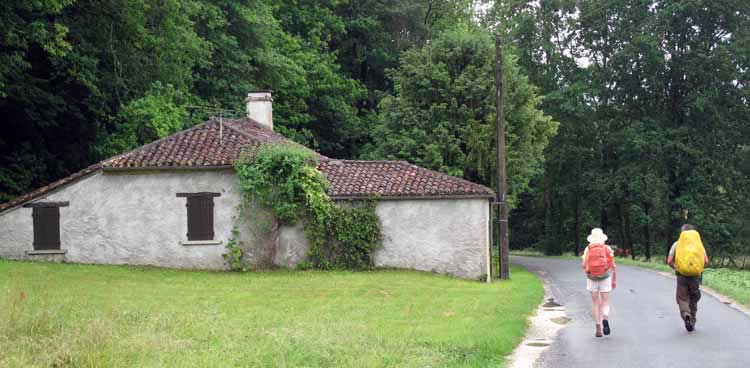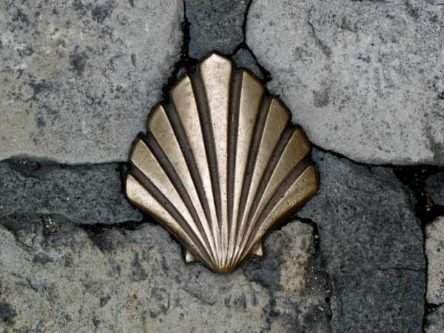
Wednesday, 9 June 2010
Distance 24 km
Duration 4 hours 50 minutes
Ascent 288 m, descent 320 m
Map 48 of the TOP100 blue series (or Map 153 in the new lime-green series)
All night the rain had poured down and it was still doing so at breakfast time. Nevertheless I wore shorts, for the second day in a row, and by the time we set off at 8 o’clock, the sky had cleared.

We were still not used to the comfort of having breakfast provided before starting out. Marc left first, as it was his last day on the track and he wanted to get home to Tarbes that evening.
We had to say goodbye to Peter, who cried again, especially over the parting from Kees, his companion and protector for so many weeks.
Peter was to spend a second night with the good men of Sorges, and then get a taxi to Périgueux and a train home.

We three strode off together, Kees relishing his new freedom from responsibility. We crossed the D8 and the pilgrim signs took us along the quiet D106, then off to Cornille. He was a speedy walker, like us, so we very soon passed Marc.
The sodden, undulating fields had plantings of young wheat, rapeseed and sunflower, and newly cut haybales.
We talked about all sorts of things. Kees’ job as a rat-catcher required him to walk miles in the countryside every day. Although he was not religious, he loved and respected nature in an almost religious way.

We had a lot in common with him, we felt. On the other hand, he spent long periods on the telephone to his wife in Holland as he walked, which rather destroyed the image of a simple nature-worshipper.
There were ripe cherries beside the track as we entered Cornille, but that was the only refreshment the village had to offer. We had hoped for a bar but there was only a closed restaurant.

At this juncture the pilgrim signs went left on a small road, while the road sign to Périgueux pointed straight ahead. After hesitating, we went with the pilgrimage, which turned out to be a bad mistake.
Before long we crossed the D8, last seen as we left Sorges, and the pilgrim signs plunged off the bitumen on a thin, muddy track.
We stayed on the road but found ourselves wandering to and fro, constantly forced to turn east, away from the direction we wanted. Time passed, houses became more frequent and we started to descend towards the river.

Feeling that we were on the outskirts of Périgueux at last, I asked a man slashing weeds in a ditch below the road, how far it was.
“About five kilometres” was the reply, and if I could have got down to him, I would have strangled him on the spot. We were heartily sick of our perambulations, but there was nothing to do but continue.

We started to hear traffic and then we saw a row of big hardware shops on the road parallel to ours, lower down the slope. It was the highway beside the river Isle, and we lost no time getting down to it.
Straight away we found a bar, and while Kees and I went in, Keith scouted around and brought back pastries for our second breakfast. It was well past midday and we had been walking non-stop for over four hours but our need for a second breakfast would not be denied .
Setting off again, we still had a long trudge ahead of us, but we were refreshed and happy to be on the highway rather than the accursed scenic road that we had been on before. It was shorter and there was more to look at. A helpful passer-by suggested that we go down to the riverside footpath, which was more beautiful, but we had lost interest in beauty.

From the district of Trelissac we gradually made it into the centre of Périgueux, which we recognised by the pale, clustered domes of the cathedral ahead. We remembered the cobbled lanes from our first visit, and they looked just as good now.
The guardians last night had rung ahead to book us into the gîte at Périgueux, and instructed us how to get there. We would arrive in the town from above, they said, and would find it at the top of Avenue Georges Pompidou.
Since we had got lost and come in along the river, we had to walk uphill through the lanes, and on the way we met Marc coming down. He had arrived at the same time as us although he walked at half the pace. It was good to see him but we felt peeved all the same.

We found the gîte without trouble. It was a huge, ugly, three-storey concrete box, set back from the road and surrounded by bitumen, probably a former seminary or hospital. We wandered around and came to a restaurant with a canopied terrace.
It was deserted and we remembered that Jacques had said that the gîte was closed on Wednesday afternoons, which is why we had to book in before 3 o’clock. Normally gîtes only accept visitors after 4 o’clock.
Having found some official person inside the restaurant, we paid and got room keys and a code to open the outer door. Breakfast would be at 7:45 sharp, he said. The accommodation was made up of separate rooms, each of two beds, with a bathroom down the corridor.

We had booked for four people, including Peter, so Kees had to pay for a whole room himself (€29). We went up in a lift to the second floor and walked along a wide, dark, silent corridor to our rooms.
It was as if the place had been abandoned to a nameless plague. In the bathroom the hot water must have come from the centre of the earth, it took so long to arrive.
Light rain was falling outside as we arranged ourselves comfortably on our beds for lunch, and then fell into a blissful doze. It was about 6 o’clock when we emerged. Apart from a couple of solitary people on the terrace studying bibles, there were no signs of life.
We started off down the Avenue Georges Pompidou and we had only gone a short way when we saw our old companion Henk coming up. We had not seen him since Saint-Léonard-de-Noblat, and had assumed that he was far ahead. In fact he had fallen behind and had come all the way from Thiviers today.

The Office of Tourism in Périgueux had sent him up to the gîte, apparently unaware that it would be closed on Wednesday afternoon. It was another example of the breathtaking ignorance that we had encountered so often in Offices of Tourism, mixed in with much useful advice.
We were delighted to see each other again, and we soon realised that there was a spare bed in Kees’ room, and that we had the code to get into the building. We rushed back to the gîte together and found Kees in the corridor, just coming back from a shower.
All was arranged in a moment and our two friends (who had met before in some long-ago gîte) began speaking in Dutch. It was a rare pleasure for them both and we could hardly get a word of English out of them for the rest of the evening.

When Henk had showered and changed, all four of us went down to the town to look for dinner. The lanes were suffused in golden lamplight, as they had been on our last visit.
We suggested eating in the Place Saint-Louis, and it was just as pleasant as before, with several busy restaurants operating. It had stopped drizzling so we sat outside. We had €12 menus and a litre of red (for some reason it was cheaper to get a 250ml and a 750ml than two half-litres).
We began with a salad of chèvre chaud for Keith and a tarte with salad for me, while the Dutchmen had soup.

Then all three men had steak with chips and I had a large leg of poultry, more like a baby emu’s leg than that of a guinea fowl, with green beans and sauteed potatoes.
Lastly there were chocolate creams but I swapped mine for a coffee.
Kees intended to leave early in the morning and make a dash for Bergerac, sleeping in hedges if necessary. He was keen to make up time now that his duties with Peter were over.
We described our previous visit to Bergerac, and he remarked how odd it was to be getting advice about France from a pair of Australians. Neither Kees nor Henk had ever been in France before, although they lived so close to it.
Previous day: La Coquille to Sorges